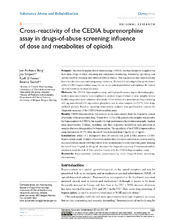| dc.contributor.author | Berg, Jon Andsnes | en_US |
| dc.contributor.author | Schjøtt, Jan | en_US |
| dc.contributor.author | Fossan, Kjell Ove | en_US |
| dc.contributor.author | Riedel, Bettina | en_US |
| dc.date.accessioned | 2016-08-03T11:45:46Z | |
| dc.date.available | 2016-08-03T11:45:46Z | |
| dc.date.issued | 2015-10-28 | |
| dc.Published | Substance Abuse and Rehabilitation 2015, 6:131-139 | eng |
| dc.identifier.issn | 1179-8467 | |
| dc.identifier.uri | https://hdl.handle.net/1956/12418 | |
| dc.description.abstract | Purpose: The cloned enzyme donor immunoassay (CEDIA) for buprenorphine is applied for both urine drugs-of-abuse screening and compliance monitoring. Sensitivity, specificity, and optimal cutoff of this assay have differed between studies. This may indicate that cross-reactivity has to be taken into account during assay evaluation. We therefore investigated the performance of the CEDIA buprenorphine assay for use in our patient population and explored the impact of cross-reactivity on assay accuracy. Methods: The CEDIA buprenorphine assay and high-performance liquid chromatography–tandem mass spectrometry were employed to analyze drugs-of-abuse in urine samples from a healthy drug-naïve male volunteer after intake of two tablets of a prescription drug containing 400 mg paracetamol +30 mg codeine phosphate, and in urine samples (n=2,272) from drug-addicted patients. Receiver operating characteristic analyses were performed to express the diagnostic accuracy of the CEDIA buprenorphine assay. Results: CEDIA buprenorphine was positive in one urine sample from the drug-naïve person after intake of the prescription drug. Twenty-five (1.1%) of the patient urine samples were positive for buprenorphine by CEDIA, but negative by high-performance liquid chromatography–tandem mass spectrometry. Codeine, morphine, and their respective metabolites were prevalent in samples that were false positive for buprenorphine. The specificity of the CEDIA buprenorphine assay increased to 99.7% when the cutoff was increased from 5 ng/mL to 10 ng/mL. Conclusion: Intake of a therapeutic dose of codeine can yield a false-positive CEDIA buprenorphine result. Additive effects from metabolites of codeine contribute to cross-reactivity in concentrations much lower than listed in the manufacturer's cross-reactivity guide. Raising the cutoff from 5 ng/mL to 10 ng/mL increased the diagnostic accuracy. Clinicians should be informed about the risk of false-positive results with the CEDIA buprenorphine assay. | en_US |
| dc.language.iso | eng | eng |
| dc.publisher | Dove Medical Press | eng |
| dc.rights | Attribution CC BY-NC | eng |
| dc.rights.uri | http://creativecommons.org/licenses/by-nc/3.0/ | eng |
| dc.subject | buprenorphine | eng |
| dc.subject | codeine | eng |
| dc.subject | cross-reactivity | eng |
| dc.subject | urine drugs-of-abuse screening | eng |
| dc.subject | immunoassay | eng |
| dc.title | Cross-reactivity of the CEDIA buprenorphine assay in drugs-of-abuse screening: influence of dose and metabolites of opioids | en_US |
| dc.type | Peer reviewed | |
| dc.type | Journal article | |
| dc.date.updated | 2016-04-07T13:23:26Z | |
| dc.description.version | publishedVersion | en_US |
| dc.rights.holder | Copyright 2015 The Authors | |
| dc.identifier.doi | https://doi.org/10.2147/sar.s88935 | |
| dc.identifier.cristin | 1289627 | |

